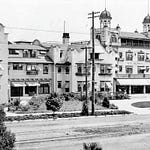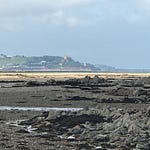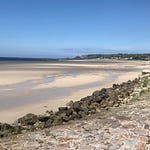In this episode, we continue the story of the Battle of Jersey. It is January 6th, 1781, and a French army is marching into St Helier….
Daybreak bursts in on St Helier like a volley of gunshots through a window. The army of wraiths swoops like a wake of vultures on its first victims. The Legion of Luxembourg is rampaging brazenly down La Colomberie, crashing and howling like a pack of feral dogs on the warpath.
Poor old Pierre Arrivé, hearing a commotion, opens his front door to lambast the noisy youths and is slaughtered on the spot. Other civilians are beaten and bound. The French mercenaries are breaking into houses now, seizing hostages and raising hell. The town’s librarian is bound and gagged, and they drag the artillery commander away in his nightgown and slippers. The Baron’s men herd the humiliated Town militia away like dumb cattle. The coup is nearly complete.
At last, the final catastrophe breaks upon the indolent, slumbering Lieutenant-Governor himself. Half-dressed, the shell-shocked Major Corbet is roused by the cries of his frantic, dishevelled captain. Minutes later the French tidal wave smashes with full force into the pomp and glory of the Manoir of La Motte. The hapless Corbet is dragged down from his bedroom like a puppet, and the articles of capitulation are dangled in front of his twitching nose. It will be so easy, so painless, they promise. Anyone would understand, and we will treat you well. At first Corbet demurs, resists and slithers, as if he could bluster for time, but the man with the gun makes the rules. The choice is stark: unconditional surrender, or the first summary executions will start in thirty minutes. De Rullecourt’s eyes seethe with venom; he is nothing if not a man of his word.
So Major Corbet washes his hands with unseemly haste, absolving his tortured conscience with the limp excuse of duress, hiding like a child behind the legalistic niceties he learned so well in his salad days as a London lawyer. It is so much better after all to bend with the wind, rather than break. He looks outside over his little houses, the streets of St Helier, now just another provincial French port.
Jersey’s capitulation slips from his pen as the winter sun rises. The victorious Baron struts bombastically through town to survey his new domain. He sends out invitations for dinner, and in his magnanimity orders a fattened goose to celebrate. The prodigal Island has come home.
An old roué and ingrate like the Baron should have known that fortune can be a capricious lover. The story unfolds like clockwork: first struts in hubris, closely followed by its blood brother, nemesis. The hidden playwrights of history decide to summon forth a wild card. He is by all accounts a bold and capable lad, a young officer of twenty-four. His hitherto unknown name is about to blaze briefly and fiercely, and on these little hinges a great door will turn. Major Francis Peirson marches to seize fate directly by the scruff of the neck, and make it release its prey.

Peer behind the florid Victorian hagiography and the refined tableau of bloodless sacrifice. The truth of Peirson’s fatal charge is raw, pungent and disorientating. For fifteen minutes the angel of death sets up camp in the Market Square, under the blind golden eyes of King George II. The air throngs with cries in English and French, and with screams of agony that transcend all language. Peirson suddenly breaks through at the head of the brave redcoats of the 95th Regiment, down Avenue du Marché into the Square. A musket ball smashes open his heart. He is dead, and a fearsome and reckless surge of rage engulfs his men. Then the air splinters with gunfire and hearts surge with adrenaline. Blood-red infantry are suddenly flooding down from Rue de Derrière, fired with the hope of glory and fighting with the boundless fury of men who will die to avenge their fallen leader.
The Highlanders too are closing in from Vine Street. These are brave men pressed hard into the King’s shilling, their mouths blackened and stained with the taint of musket powder. Their drill is as natural as breathing: rip the cartridge with your teeth, pour in the powder, ram down the lead shot, and aim with lethal precision. Repeat. Kill. Repeat. Men retch at the acrid, choking smell of the guns, the brutal impact of musket balls smashing flesh and bone, earth and stone, the cloying stench of the mounting butcher’s bill. The French gunners unleash the town cannon, but their shot falls far too high; seared with fear and drenched in terror, they abandon them and flee. Momentum has turned and the French line collapses.
Now the final act in the tragedy begins. Baron de Rullecourt emerges out of the shadow of the old Courthouse now, still draped in the coveted blood-red sash of St Louis. He struts and parades on the steps, shouting unheard words into the mire, dragging the hapless Corbet as a human shield. He is brazenly baiting the muskets and daring them to fire on them both. The desperate gambler is playing his final card. It tumbles stone dead on to the cold flagstones before the foot of a golden king.
The French prisoners, disconsolate and disarmed, trudge into the nearby Town Church. They are herded between the holy walls like lost sheep, their white and blue uniforms singed by battle, cursing the twist of fate that has left them abandoned here. They sing sad laments, dreading the English prison ships, the fearsome hulks, which surely await them. Lieutenant-Governor Corbet guiltily resumes command, even though he too suspects that trial and disgrace are lurking around the corner, waiting for him like thieves.
So in the end there were only funerals: full military honours for the tragic, doomed Baron, laid to rest for eternity outside the Town Church’s door. Meanwhile Peirson, the brave young man who saved Jersey, lies in honour beneath the pulpit.
The old order will soon change, as history lurches forward again. The kingdom of France itself will collapse within a dozen years, razed by the earthquake of revolution that came, to coin a phrase, like a thief in the night. Yet the ancient parish church of St Helier will remain, with its buried hero and villain entombed here, duelling for eternity. These walls remember, but they will never speak of what they have seen. So, the violent heat and pain of an ancient battle is frozen in time here as a marble memorial, or the image on a thousand Jersey bank notes, a winter’s tale.
~ Adapted from my first book, Jersey: The Hidden Histories (c) Paul Darroch 2015, 2021














